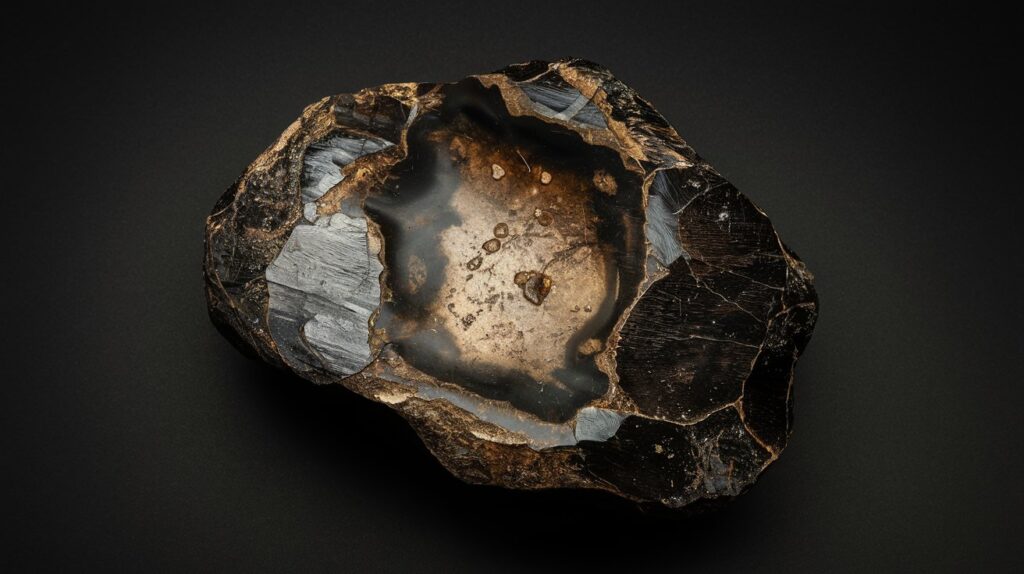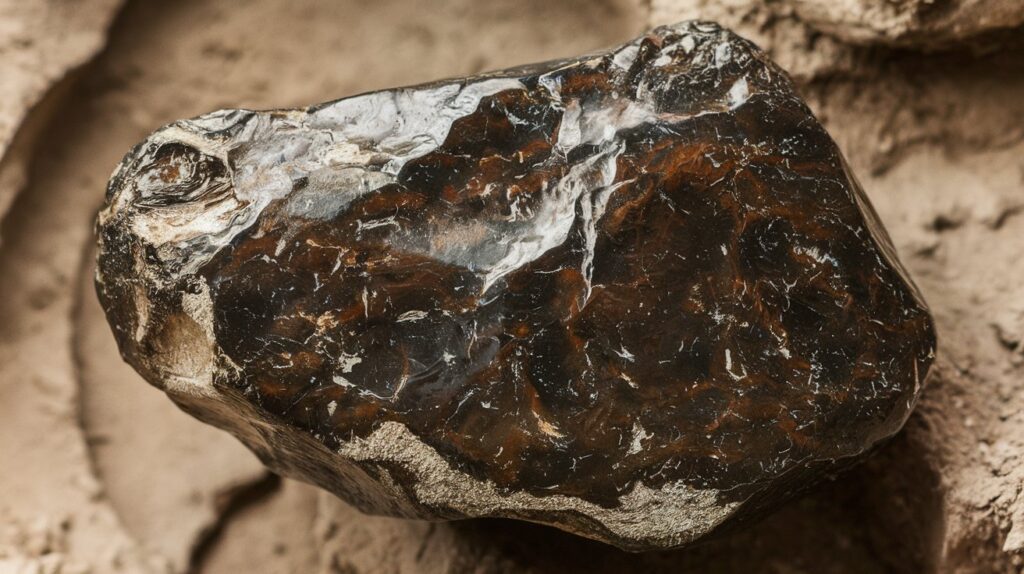
Chondrite meteorites, some of the oldest objects in our solar system, hold essential clues to the origins of planets and the building blocks of life. They account for more than 85% of meteorite falls, making them the most abundant type of meteorite. These stony meteorites have remained largely unchanged since their formation over 4.6 billion years ago, providing a unique window into the early history of the solar system.
This blog will give you a comprehensive yet user-friendly overview of chondrites, their significance, composition, classification, and the mysteries they help us unravel about our universe.
What Are Chondrites?
Chondrites are a class of stony meteorites that are rich in spherical mineral grains called chondrules. These chondrules are a defining feature, giving the meteorites their characteristic texture. Unlike other meteorites, chondrites have not been altered by processes like melting or differentiation. This means they have retained the original material from the early solar system, making them scientifically significant.
“Chondrites are stony meteorites that have not been modified due to melting or differentiation of the parent body.“
One of the most intriguing aspects of chondrites is that they have remained unaltered while entering Earth’s atmosphere, preserving ancient cosmic information.

Key Features of Chondrites
- Most abundant meteorite class, constituting over 85% of meteorite falls.
- Contain chondrules—round grains formed by molten droplets in space.
- Have not undergone significant alteration by heat or pressure.
- Provide insights into the formation of the solar system.
Classification of Chondrites
Chondrites are classified based on their mineralogy, chemistry, and isotopic composition. The two main types of chondrites are:
- Ordinary Chondrites
Ordinary chondrites are the most common, making up about 87% of all chondrites. They are further subdivided into three groups:- H chondrites: High in iron content.
- L chondrites: Low in iron.
- LL chondrites: Very low in iron.
- Carbonaceous Chondrites
Carbonaceous chondrites are rare but crucial for understanding the early solar system. They are rich in carbon compounds, including organic molecules, which might have been the seeds of life on Earth. - Enstatite Chondrites
Enstatite chondrites are thought to have formed close to the sun and have a high content of the mineral enstatite. These meteorites may represent the building blocks of Mercury and other inner planets.
Table 1: Types of Chondrites
| Type | Iron Content | Special Feature | Percentage of Meteorites |
|---|---|---|---|
| Ordinary Chondrites | Varies (H, L) | Most common type | 87% |
| Carbonaceous Chondrites | Low | Rich in organic compounds | 5% |
| Enstatite Chondrites | High | Formed close to the sun | 2% |
Formation of Chondrites
The formation of chondrites dates back over 4.6 billion years, to the very beginning of the solar system. Chondrites are believed to have formed from the solar nebula—a disk of gas and dust surrounding the young sun. As this nebula cooled, particles began to stick together, forming small clumps. These clumps eventually became chondrules, which were heated briefly and rapidly cooled, retaining their spherical shape.
The final stage in the formation of chondrites involves these chondrules accumulating more dust and material, eventually forming larger bodies called planetesimals. Some of these bodies remained unchanged and eventually fell to Earth as meteorites.
Chondrites are a type of stony meteorite that provide valuable insights into the early solar system. They are primarily composed of small spherical grains called chondrules, which formed through rapid heating and cooling processes. Here’s a brief overview of their formation:
- Solar Nebula: Chondrites originated from the solar nebula, the cloud of gas and dust that surrounded the young Sun.
- Chondrule Formation: Chondrules formed through brief heating events, possibly from shock waves, radiation from nearby stars, or other energetic processes. These molten droplets then cooled quickly, solidifying into spherical shapes.
- Accretion: Over time, these chondrules and other materials (like refractory inclusions) aggregated together through gravitational attraction and electrostatic forces, forming larger bodies.
- Parent Body: Many chondrites are thought to have originated from differentiated or undifferentiated parent bodies—small planets or asteroids that may have experienced heating and some degree of melting.
- Ablation and Ejection: Impacts and collisions in the asteroid belt could have ejected these materials into space, allowing them to eventually fall to Earth as meteorites.
Chondrites are essential for understanding the conditions and processes that existed in the early solar system, and they are considered some of the oldest materials we can study today.
Table 2: Stages in the Formation of Chondrites
| Stage | Process Description |
|---|---|
| Solar Nebula | Disk of gas and dust surrounding the young sun. |
| Chondrule Formation | Spherical droplets form through rapid heating and cooling. |
| Accretion | Dust and particles accumulate to form larger bodies. |
| Planetesimal Formation | These larger bodies remain unaltered in space. |
Scientific Significance of Chondrites
Unlocking the Secrets of the Early Solar System
Because chondrites have not been altered by significant heat or pressure, they serve as time capsules that preserve information from the early solar system. Studying them helps scientists understand:
- The conditions that existed in the early solar system.
- The building blocks of planets.
- The origin of water and organic materials, which could explain the beginning of life on Earth.
Exploring Organic Compounds in Carbonaceous Chondrites
The discovery of organic compounds in carbonaceous chondrites has significant implications. These meteorites contain complex carbon-based molecules such as amino acids, the building blocks of proteins. This has led scientists to theorize that these compounds could have been delivered to Earth by chondrites, playing a role in the origin of life.

Chondrites and Their Role in Meteorite Falls
When chondrites enter Earth’s atmosphere, they typically remain intact, with minimal alteration. This is because chondrites are relatively sturdy and compact compared to other types of meteorites. Upon impact, they may fragment, but much of their original material is preserved.
The sheer abundance of chondrites in meteorite falls—making up over 85%—makes them the most commonly found type of meteorite on Earth. Scientists have collected thousands of chondrites from meteorite falls, which serve as vital samples for studying the universe.
Chondrites play a significant role in the study of meteorite falls due to their abundance and the insights they provide into the early solar system. Here’s an overview of their importance:
Characteristics of Chondrites
- Composition: Chondrites are primarily made up of chondrules (small, round grains) and are rich in silicate minerals and metal. They lack significant differentiation, meaning they have not undergone processes that separate materials by density.
- Types: There are several types of chondrites (e.g., ordinary, carbonaceous, and enstatite), each with distinct characteristics and formation histories.
Meteorite Falls
- Meteorite Showers: Chondrites are often the most commonly observed meteorites during falls. When a meteoroid enters the Earth’s atmosphere, it can produce bright fireballs, leading to meteorite recovery.
- Collection Sites: Many chondrites are collected from specific sites where they have landed, providing opportunities for study and analysis.
Scientific Insights
- Early Solar System: The study of chondrites gives scientists clues about the conditions and materials present in the early solar system, including the processes that led to planet formation.
- Isotopic Studies: Chondrites contain isotopic signatures that help researchers trace the origins of elements and compounds, offering insights into the solar nebula’s chemical composition.
Contributions to Planetary Science
- Comparative Analysis: Chondrites serve as a baseline for understanding the evolution of other planetary bodies, especially differentiated bodies like Earth and Mars.
- Organic Materials: Some carbonaceous chondrites contain organic compounds, which can provide clues about the origins of life and the conditions that may have supported it.
Conclusion
Chondrites are not only the most common type of meteorite found on Earth but also key to understanding the processes that shaped our solar system. Their study continues to enhance our knowledge of planetary formation, chemical evolution, and the history of materials that formed the Earth and other celestial bodies.
How to Identify a Chondrite Meteorite
If you ever come across a potential meteorite, there are a few key characteristics that can help identify it as a chondrite:
- Round chondrules: Look for spherical grains embedded in the stone.
- Metal flecks: Many chondrites contain tiny flecks of metal.
- Magnetism: Because of their metal content, chondrites can be attracted to a magnet.
- Fusion crust: Meteorites often develop a thin, black crust as they pass through the atmosphere.
Identifying a chondrite meteorite involves examining several key characteristics. Here’s a guide to help you recognize one:
1. Visual Appearance
- Exterior: Chondrites typically have a dark, rough, and often fusion-crusted surface. The crust forms as the meteorite passes through the atmosphere.
- Interior: When you break a chondrite open, the interior is usually a lighter color, often grayish or brownish, with a granular or porous texture.
2. Chondrules
- Spherical Shapes: Look for small, round grains (chondrules) embedded in the matrix. These are one of the defining features of chondrites.
- Size Variation: Chondrules can vary in size, usually ranging from a few hundred micrometers to a couple of millimeters in diameter.
3. Matrix Material
- The space between the chondrules often contains fine-grained material, which may appear as a darker matrix.
4. Mineral Composition
- Common Minerals: Chondrites are rich in silicate minerals (like olivine and pyroxene), and may also contain metal (iron-nickel) and sulfide minerals.
- Magnetism: Many chondrites contain metallic iron, so they can be magnetic. Test with a magnet to see if it sticks.
5. Density and Weight
- Chondrites are generally denser than terrestrial rocks. Weighing and measuring dimensions can help differentiate them from ordinary stones.
6. Lack of Striations
- Unlike many terrestrial rocks, chondrites usually lack distinct striations or layering. Their appearance is often more amorphous.
7. Specific Tests
- Acid Test: If you have access to hydrochloric acid, a small drop can help identify carbonates, but be cautious with this test.
- Thin Section: For more definitive identification, creating a thin section and examining it under a polarizing microscope can reveal the mineralogy and texture.
8. Consult Resources
- Meteorite Identification Guides: Utilize online databases or books that provide images and descriptions of different meteorite types.
- Expert Consultation: If you’re uncertain, consider reaching out to a local university or a meteorite specialist for assistance.
Conclusion
Identifying a chondrite meteorite requires a combination of visual inspection, physical tests, and knowledge of their unique characteristics. If you believe you’ve found one, documenting your findings and seeking expert advice can enhance your identification efforts!
Table 3: Identifying Characteristics of Chondrites
| Feature | Description |
|---|---|
| Chondrules | Small, round grains scattered throughout. |
| Metal Flecks | Tiny metal inclusions that shine. |
| Magnetism | Attracted to magnets due to metal content. |
| Fusion Crust | A thin, dark crust from atmospheric entry. |
How Do Scientists Study Chondrites?
Scientists use a variety of techniques to study chondrites, including:
- Microscopic Analysis: This involves examining chondrules and other components under a microscope to determine their composition.
- Isotopic Analysis: By studying the isotopic makeup of chondrites, scientists can trace the origins of these meteorites and gain insight into the conditions of the early solar system.
- Chemical Analysis: This allows scientists to measure the concentrations of elements like iron, magnesium, and silicon within chondrites.
Scientists study chondrites using a variety of techniques and methods to unlock their secrets and gain insights into the early solar system. Here are some of the primary approaches:
1. Petrographic Analysis
- Thin Sectioning: Chondrites are cut into thin slices and examined under a microscope to identify minerals, textures, and structures.
- Mineral Composition: Researchers analyze the composition of chondrules, inclusions, and matrix materials to understand their formation processes.
2. Chemical Analysis
- Elemental Composition: Techniques like X-ray fluorescence (XRF) and electron microprobe analysis are used to determine the abundance of various elements in the chondrites.
- Isotope Studies: Isotopic ratios (e.g., oxygen, carbon, nitrogen) help trace the origins and evolution of materials, shedding light on processes in the solar nebula.
3. Infrared and Raman Spectroscopy
- These techniques are used to analyze the molecular composition of chondrites, helping identify organic compounds and mineral phases.
4. Mass Spectrometry
- Noble Gas Analysis: By measuring noble gases trapped in chondrites, scientists can infer the history of exposure to cosmic radiation and solar wind.
- Stable Isotope Analysis: Techniques like secondary ion mass spectrometry (SIMS) allow for high-precision measurements of isotopic compositions.
5. Radiometric Dating
- Methods such as uranium-lead or potassium-argon dating help determine the ages of chondrites and their components, providing timelines for formation processes.
6. Meteorite Recovery and Field Studies
- Scientists participate in meteorite recovery expeditions, documenting the locations and contexts of falls, which is crucial for understanding their history and environment.
7. Computational Modeling
- Simulations of the solar nebula and chondrule formation help researchers hypothesize about the conditions under which chondrites formed.
8. Comparative Studies
- By comparing chondrites with other meteorites and planetary materials, scientists can draw broader conclusions about planetary formation and evolution.
Conclusion
Through these diverse techniques, scientists can piece together the complex history of chondrites, revealing critical information about the early solar system and the processes that shaped our planets. Each study adds to the overall understanding of cosmic history and the materials that make up our solar system.

Takeaways from Chondrite Study:
- Chondrites offer a unique glimpse into the early solar system.
- Their unchanged composition makes them invaluable for scientific research.
- Organic compounds found in chondrites may have contributed to the origin of life on Earth.
Conclusion
Chondrites are extraordinary objects, offering a direct link to the earliest days of our solar system. They are not only the most abundant type of meteorite but also serve as natural archives, preserving ancient materials that have remained unaltered for billions of years. The study of chondrites has contributed significantly to our understanding of planetary formation, the origins of water and organic compounds, and even the potential for life beyond Earth.
As the most common type of meteorite, chondrites continue to fascinate both scientists and enthusiasts alike, providing endless opportunities for research and discovery.
Important Point
| NO. | Important Points |
| 1. | About Us |
| 2. | Contact Us |
| 3. | Disclaimer |
| 4. | Privacy Policy |
FAQs of Chondrite
What are chondrites?
Chondrites are a type of stony meteorite that contains small, round grains called chondrules. These meteorites have not been altered by melting or differentiation, making them valuable for studying the early solar system.
Why are chondrites important?
Chondrites are the most abundant type of meteorite and provide critical information about the formation of planets and the materials present in the early solar system. Some chondrites even contain organic compounds that could explain the origin of life on Earth.
How do scientists study chondrites?
Scientists use a combination of microscopic, isotopic, and chemical analyses to study the composition of chondrites. These methods allow them to trace the meteorites’ origins and gain insight into the conditions of the early solar system.
What are chondrules?
Chondrules are small, spherical mineral grains found in chondrites. They were formed by rapid heating and cooling in the early solar system and are a defining feature of these meteorites.
Where do most chondrites come from?
Most chondrites come from the asteroid belt between Mars and Jupiter. These asteroids are remnants of the early solar system that never formed into planets.
